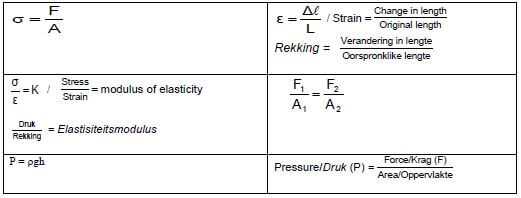TECHNICAL SCIENCES PAPER 1 GRADE 12 QUESTIONS - NSC PAST PAPERS AND MEMOS JUNE 2022
Share via Whatsapp Join our WhatsApp Group Join our Telegram GroupINSTRUCTIONS AND INFORMATION
- Write your FULL NAME and SURNAME in the appropriate spaces on the ANSWER SHEET.
- Answer ALL the questions.
- Start each question on a NEW page in the ANSWER BOOK.
- You may use a non-programmable calculator.
- You may use appropriate mathematical instruments.
- Number the answers correctly according to the numbering system used in this question paper.
- Show ALL formulae and substitutions in ALL calculations.
- Round off your FINAL numerical answers to a minimum of TWO decimal places.
- Give brief motivations, discussions, et cetera where required.
- You are advised to use the attached DATA SHEET.
- Write neatly and legibly.
QUESTIONS
QUESTION 1: MULTIPLE-CHOICE QUESTIONS
Various options are provided as possible answers to the following questions. Choose the answer and write the letter (A–D) next to the question numbers
(1.1 to 1.10) in the ANSWER BOOK, for example 1.11 E.
1.1 The SI unit for momentum of a body is …
- N.
- N.m.
- kg.m.s-1.
- kg.m.s-2. (2)
1.2 The perpendicular force exerted by a surface on an object that lies on the surface is called …
- weight.
- normal.
- applied force.
- friction force. (2)
1.3 A minibus taxi is moving along a straight road with its sliding door open. When the taxi driver applies brakes suddenly, it is observed that the door moves forward.
What NAME is given to the law that explains this observation?
- Pascal’s Law
- Newton’s First Law
- Newton’s Third Law
- Newton’s Second Law (2)
1.4 Power is defined as …
- rate at which work is done.
- energy transferred.
- product of net force and time.
- product of mass and acceleration. (2)
1.5 A girl applies a constant force of 100 N at an angle of θ to the horizontal on a block as shown in the sketch below. The frictional force acting on the block is 14 N.
The block accelerates to the west.
What is the magnitude of the force (in N) that the block exerts on the girl?
- 100 N
- 100 sin θ
- 100 cos θ
- 100 cos θ – 14 (2)
1.6 A graph of a constant net force acting on a body versus time over which the force acts, is shown below.
The corresponding change in momentum (Δp) versus time graph is represented by: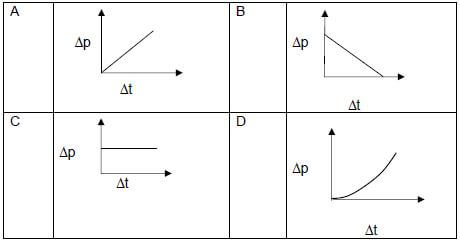
1.7 A block of mass m is allowed to slide down from rest along THREE FRICTIONLESS paths P, Q and R. The block starts moving from the same height h for each path.
Along which path will the block reach the ground at the HIGHEST speed?
- P
- Q
- R
- The block will reach the ground at same speed for all the paths. (2)
1.8 The MAXIMUM FORCE that can be applied to a body so that it regains its original form completely on removal of the force, is called …
- thrust.
- elastic limit.
- tension.
- elasticity. (2)
1.9 TWO oil containers P and Q are marked as follows:
P: 10W – 30 Q: 20W – 50
Which ONE of the following statements is CORRECT about the oil in container P?
The oil in container P …
- is more suitable for cold conditions.
- is more suitable for hot conditions.
- has a higher viscosity in cold conditions than oil in container Q.
- will stay thicker in hot conditions than the oil in container Q. (2)
1.10 The collective name given to the seven colours of white light is …
- prism.
- spectrum.
- primary colours.
- secondary colours. (2)
[20]
QUESTION 2 (Start on a new page.)
The picture shows a girl pulling a sled by means of a rope which is inclined at 42˚ to the ground. The tension in the rope is 100 N. The sled moves at a CONSTANT VELOCITY to the right.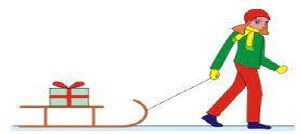
2.1 State Newton’s First Law of Motion in words. (2)
2.2 The girl observes that pulling the sled from a stationary position to get it moving, is more difficult than pulling it when it is in motion. Explain. (2)
2.3 Calculate the kinetic frictional force acting on the sled. (3)
2.4 The girl increases the angle at which the rope is inclined to the ground surface to 60° while keeping the tension in the string at 100 N.
How will the following quantities be affected?
(Write only DECREASE, INCREASE or REMAINS THE SAME.)
2.4.1 Normal force (1)
2.4.2 Kinetic frictional force (1)
2.5 Explain your answer to QUESTION 2.4.2 above. (2)
[11]
QUESTION 3 (Start on a new page.)
The diagram below shows a box of mass 4 kg that accelerates on a rough surface to the right. A girl applies a force 100 N at an angle of 30° to the horizontal.
3.1 Write only the question numbers and the missing words:
According to Newton’s Second Law the (3.1.1) … produced by a net force is (3.1.2) … to the net force if the mass of the body remains constant. (2)
3.2 Draw a labelled free body diagram for all the forces acting on the box. (5)
3.3 Calculate the:
3.3.1 Vertical component of the 100 N force (3)
3.3.2 Kinetic frictional force if the coefficient of kinetic friction is 0,15 (3)
3.3.3 Horizontal component of the 100 N force (3)
3.4 A force F is applied to the box and the box accelerates at 0,2 m.s-2 to the left. Calculate force F.  (4)
(4)
[20]
QUESTION 4 (Start on a new page.)
A truck, P of mass 2 x 103 kg moving to the right collides with a stationary cart of mass 1 800 kg as shown in the diagram below.
After the collision the truck and cart couple and move as a single unit to the
right with total kinetic energy of 1,216 x 103 J.
A loud bang is heard when the truck and the cart collide.
4.1 Define the term isolated system. (2)
4.2 Is this collision ELASTIC or INELASTIC? Explain. (No calculation is required.) (2)
4.3 Calculate the magnitude of the velocity of the truck before the collision. (7)
4.4 State the principle you used to answer QUESTION 4.3 above, in words. (2)
The collision between the truck and cart lasted 0,1 s.
4.5 Calculate the net force on the truck. The truck has a crumple zone in its front to reduce the extent of injuries to its occupants. (4)
4.6 Explain how crumple zones reduce injuries. (3)
[20]
QUESTION 5 (Start on a new page.)
5.1 A learner pushes a box with a horizontal force of 50 N across a ROUGH surface ABC. Part AB is 3,2 m long. The friction force on AB is 2 N.
Calculate the:
5.1.1 Work done by the learner to move the box from A to B (3)
5.1.2 Net work done in moving the box from A to B (4)
The box moves from B to C with a constant velocity of 2 m.s-1, while the force of 50 N still acts on the box.
5.1.3 Calculate the power delivered by the learner in moving the box from B to C. Express your answer in horsepower. (4)
5.2 A block of mass 0,5 kg is dropped from rest, at point P. The block reaches point Q after falling from a height of 15 m. Ignore AIR FRICTION.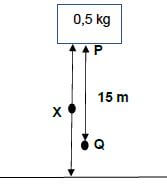
5.2.1 Define gravitational potential energy. (2)
5.2.2 State the principle of conservation of mechanical energy in words. (2)
5.2.3 Calculate the potential energy of the block at point Q. (3)
Point X is the half-way point of the block’s fall.
5.3 Calculate the total mechanical energy of the box if it passes point X at a speed of 14 m.s-1. (4)
[22]
QUESTION 6 (Start on a new page.)
6.1 Distinguish between a deforming force and a restoring force. (4)
6.2 A concrete pole that is 250 mm long with a diameter of 80 mm is supporting a load of weight of 1 925 N as shown in the diagram below.
The modulus of elasticity is equal to 190 GPa.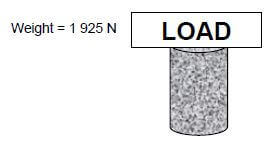
6.2.1 Define strain. (2)
Calculate the:
6.2.2 Stress in the pole (3)
6.2.3 Change in the length of the pole (5)
6.3 Study the stress-strain graph below.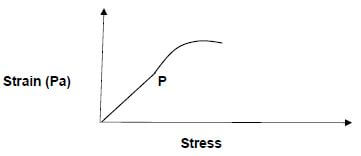
6.3.1 Name the law that is illustrated in the graph. (1)
6.3.2 What does the gradient of the graph represent? (1)
6.3.3 Give a reason why the graph does not continue as a straight line after point P. (2)
6.4 A hydraulic system is used to lift a 2 000 kg vehicle in a garage. The vehicle sits on a piston with an area of 0,4 m2.
6.4.1 State Pascal’s principle in words. (2)
6.4.2 Complete the following: 1 bar = … Pa (1)
6.4.3 Calculate the minimum force that must be applied on the input piston with an area of 0,03 m2 to lift the vehicle. (3)
6.5 Give a reason why dam walls are wider and thicker at the bottom than at the top. (2)
6.6 Write down the relationship between the temperature and the viscosity of liquids. (2)
[28]
QUESTION 7 (Start on a new page.)
7.1 State the law of reflection of light. (2)
7.2 Write down TWO properties of an image formed by a plane mirror. (2)
7.3 The diagrams below show the refraction of light in a semi-circular glass prism:
The sizes of the angles are:
a = 38˚
b = 41˚
c = 43˚
7.3.1 Define refraction of light. (2)
7.3.2 What NAME is given to the angle of incidence labelled b in Diagram 2? (1)
7.3.3 Which medium (GLASS or AIR), is optically denser? (1)
7.3.4 In which diagram (1 or 3) will total internal reflection occur? Give a reason for your answer. (2)
7.3.5 Write down TWO applications of total internal reflection. (2)
7.4 An object which is 15 mm high is placed 50 mm in front of a convex lens with a focal length of 30 mm.
7.4.1 Draw an accurate ray diagram to determine the position and height of the image. (5)
7.4.2 Is the image REAL or VIRTUAL? (1)
[18]
QUESTION 8 (Start on a new page.)
The diagram below shows some parts of the electromagnetic spectrum. Visible light is split into its seven constituent colours as shown in the diagram.
8.1 Give a term for the underlined sentence. (1)
8.2 Name the parts of the electromagnetic spectrum labelled in the diagram above as:
8.2.1 P (1)
8.2.2 Q (1)
8.3 Arrange P, Q and X-rays in the order of increasing wavelength. (2)
8.4 The wavelength range of UV light photons is between 10-8 m to 10-6 m.
8.4.1 Define the term photon. (2)
8.4.2 Calculate the MAXIMUM energy of a photon of UV light. (4)
[11]
TOTAL: 150
DATA FOR TECHNICAL SCIENCES GRADE 12
PAPER 1
TABLE 1: PHYSICAL CONSTANTS
| NAME | SYMBOL | VALUE |
| Acceleration due to gravity | G | 9,8 m·s-2 |
| Permittivity of free space | ?0 | 8,85 × 10-2 F.m-1 |
TABLE 2: FORMULAE
FORCE
WORK, ENERGY AND POWER
ELASTICITY, VISCOSITY AND HYDRAULICS